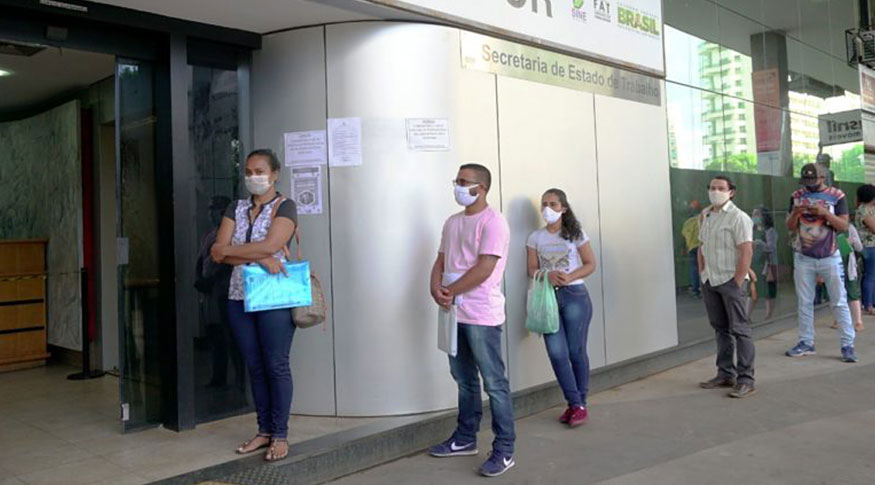Continuous PNAD
Unemployment reaches 14.7% in Q1 - highest figure since 2012
May 27, 2021 09h00 AM | Last Updated: May 27, 2021 07h14 PM
Highlights
- In three months, another 880,000 unemployed persons started looking for work.
- The employed population has remained stable, but the employment-to-population ratio has decreased and has been below 50% since the quarter ended in May 2020.
- Employment of private and public sector employees without a formal contract fell and only the self-employed category grew.
- Number of employers with CNPJ is the lowest in the series.
- Informality is stable (39.6%), with 34.0 million persons.
- The number of underutilized workers reached 33.2 million and hit a record in the series.
- In comparison with the first quarter of 2020, seven groups of activity lost employed personnel, with growth only in agriculture, livestock and forestry.
- Real wage bill is R $ 212.5 billion.

The unemployment rate rose to 14.7% in the first quarter this year, an increase of 0.8 percentage points in comparison with the last quarter of 2020 (13.9%). This corresponds to another 880 thousand unemployed persons, totaling 14.8 million lined up for a job in the country. It is the highest rate and the largest amount of unemployed persons in all quarters of the time series, which started in 2012.
Data are from the Continuous National Household Sample Survey - Continuous PNAD, released today (May 27) by the IBGE.
"The increase in the unemployed population is an expected seasonal effect. The unemployment rates use to rise in the beginning of each year, due to the layoff process of personnel hired for the holidays in the year before. With the layoffs in the first months of the year, they tend to put the labor market under pressure again" explains the survey analyst Ms. Adriana Beringuy.
The analyst also says that the number of employed workers (85.7 million) was statistically stable in the comparison with the last quarter of the previous year. But the employment-population ratio (48.4%) fell 0.5 percentage points. The employment-to-population ratio has been below 50% since the quarter ended in May last year - which indicates that less than half of the population at working age is employed in the country.
"This reduction of the employment-to-population ratio has been influenced by the retraction of employment throughout 2020, when many people lost their jobs. In one-year time, comparing with the first quarter of 2020, the employed population was reduced by 6.6 million persons", said Ms. Beringuy, indicating that pandemic impacts were only visible in the labor market by the end of March last year.
Most of the indicators were stable in the first quarter this year. Among the category of workers, there was reduction of the employees in the private sector without a formal contract (9.7 million), a drop of 2.9% with 294 thousand less persons. Employees in the public sector without a formal contract were also reduced (1.9 million), a drop of 17.1% or 395 thousand less persons.
The only increase occurred among the self-employed workers (23.8 million), growing 2.4%, an increase of 565 thousand jobs.
As to private sector workers with a formal contract, there was stability (29.6 million). In the annual comparison, however, there was decrease of 10.7% or 3.5 million less persons. Domestic workers were estimated at 4.9 million persons in the first quarter this year. Over the same quarter a year ago, this category decreased by 1.0 million persons.
Although statistically stable, the number of employers with CNPJ (3.0 millions) was the lowest in the time series started in the fourth quarter of 2015, when the survey began to differentiate between professionals with and without a CNPJ.
The informality rate was 39.6% in the first quarter this year, which is equivalent to 34.0 million persons, standing stable in relation to the previous quarter (39.5%). Informal workers are those without a formal contract (private sector employees or domestic workers), without a CNPJ (employers and self-employed persons) or without any compensation.
Labor underutilization and discouraged rates boost
Another highlight of the survey was the high in the total of underutilized persons, who are those unemployed, time-related unemployed or in the potential workforce. In the first quarter, the amount reached 33.2 million, the highest figure in the comparable series - a rise of 3.7% with 1.2 million more persons.
The discouraged ones, those who gave up job searching due to structural conditions of the labor market, amounted to 6.0 million persons - a stable figure in relation to the last quarter of 2020 - but remained with the highest level of the series.
Economic activities employ less than a year ago
The analyst observes that the number of employed persons has not had significant changes in all groups of activities in the first quarter this year over the last quarter a year ago.
But when compared to the first quarter of 2020, there was reduction in seven groups: Trade, repair of motor vehicles and motorcycles (9.4% or 1.6 million less persons), lodging and food (26.1% or 1.4 million less persons), domestic services (17.3% or 1.0 million less persons), other services (18.6% or 917 thousand less persons), general industry (7.7% or 914 thousand less persons), transportation, storage and mailing (11.1% or 542 thousand less persons) and construction (5.7% or 361 thousand less persons).
Employment grew only in agriculture, livestock, forestry, fishing and aquaculture ( 4.0% or 329 thousand more persons).
"This reduction in most groups reflects the pandemic scenario. On the whole, most of the economic activities have less employed workers than they had a year ago.", concluded the researcher.
Average earnings stand steady
The survey also shows that the real average earnings of workers was R$ 2,544 in the first quarter this year, standing stable in relation to the last quarter of 2020. The real wage bill, which is the sum of all earnings of workers, also stood stable, reaching R$ 212.5 billion.
More on the survey
The Continuous PNAD is the main instrument to monitor the country's workforce. The survey's sample by quarter in Brazil corresponds to 211 thousand surveyed households. Nearly two thousand interviewers work in the survey, in 26 states and in the Federal District, integrated to the collection network of more than 500 IBGE agencies.
Due to the Covid-19 pandemic, the IBGE has implemented the telephone collection since March 17, 2020. The interviewer identity can be checked out on the Respondents page or via Call Center (0800 721 8181). The interviwer's ID or Social Security Number - data which can be requested by the respondent.



















